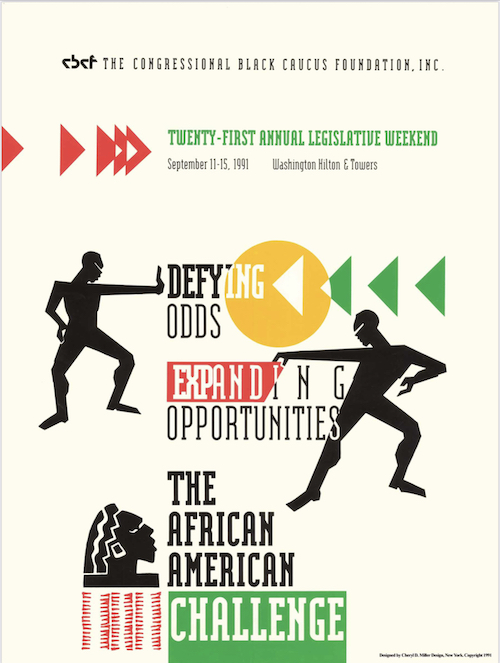Cooper Union Establishes Collection of Black Design with Cheryl D. Miller's Gift
POSTED ON: March 7, 2022
Thanks to an extraordinary gift from Cheryl D. Miller, renowned graphic designer, writer, theologian, and mentor, The Herb Lubalin Study Center of Design and Typography has established a collection dedicated to the work of Black graphic designers. The Cheryl D. Miller Collection of Black Graphic Design History at The Herb Lubalin Study Center of Design and Typography will serve as the East Coast’s premier collection for the preservation and study of the work of BIPOC designers. Beginning with Miller’s more than 50 pieces—including a copy of her graduate thesis “Transcending the Problems of Black Graphic Designers to Success in the Marketplace”, the original artwork for the famous poster she designed for the African American Challenge, and the iconic poster of Dr. Mae C. Jemison, the first Black woman in space—and some pieces from The Lubalin Center’s present holdings, the collection is expected to grow as the Lubalin Center establishes its role as a critical locus for the study of the ephemera and documents representing the work produced by BIPOC designers.
Miller, a Washington D.C. native, founded her firm, Cheryl D. Miller Design Inc., in New York in 1984. Hers was one of the very first design companies headed by a Black woman, and her portfolio includes work for BET, Philip Morris, Chase, Sports Illustrated, Time Inc., the NAACP Legal Defense Fund, the Congressional Black Caucus, and NASA.

While an undergraduate at Maryland Institute College of Art, she noted the many obstacles faced by Black Americans in the academy. Later as she built her practice while earning her MS in Communication Design at Pratt, she continually confronted the constraints imposed by racism, most notably the lack of exposure given to talented Black designers and limited access to prominent clients. She famously published her observations in Print, a magazine dedicated to graphic design, in her 1987 article entitled “Black Designers: Missing in Action.” The piece systematically analyzes the main reasons Black students are shut out of design careers—from the objections of parents who don’t see art as a path to financial security to a dearth of mentors—and the discrimination faced by those who do succeed in the field, resulting in less work and little recognition. 29 years later, she again reviewed the state-of-affairs for Black graphic designers, and the results were mixed: she noted the large increase in BIPOC design students but still found mentorship and access to high profile clients wanting.
“The more things change, the more they remain the same. But I dare say, as things remain the same and in spite of society’s paradigm shift, the black designer can be the advocate for change—the solution that is so needed today,” she wrote. “Black graphic designers have great opportunity to fill an incredible void caused by a changing American platform, palette and demographic.”
Miller, who has also established an extensive collection at Stanford University, was the 2021 AIGA Medalist. She also received the 2021 Design Visionary National Design Award, presented by Cooper Hewitt, Smithsonian Design Museum. She is the only person to receive two of the country’s highest design awards in one year. She is collaborating with a group of colleagues to build an open-source database called The History of Black Graphic Design in North America. The first initiative of the newly established collection will be the upcoming launch of the digital project, Black Artist in Graphic Communication. Funded with a grant from the New York State Council on the Arts awarded to Alexander Tochilovsky, curator of the Herb Lubalin Study Center of Design and Typography, and Laura Mircik-Sellers, Lubalin's archive coordinator, the project will create an online publication platform to showcase the work of graphic designers who were part of a seminal exhibition held in 1970 showcasing Black talent in graphic design. Cheryl wrote the introduction for this website and was an important advisor and contributor. The Cheryl D. Miller Collection of Black Graphic Design History at The Herb Lubalin Study Center of Design and Typography is accessible to anyone wishing to see it.
The upcoming digital project, Black Artist in Graphic Communication, is made possible by the New York State Council on the Arts with the support of the Office of the Governor and the New York State Legislature.
*(l) Launch poster for launch site for first African American female Astronaut, Dr. Mae C. Jemison. Client: NASA Commission, 1992
(r) "Transcending The Problems Of The Black Graphic Designer To Success In The Marketplace." Pratt Institute graduate thesis, May 1985.






